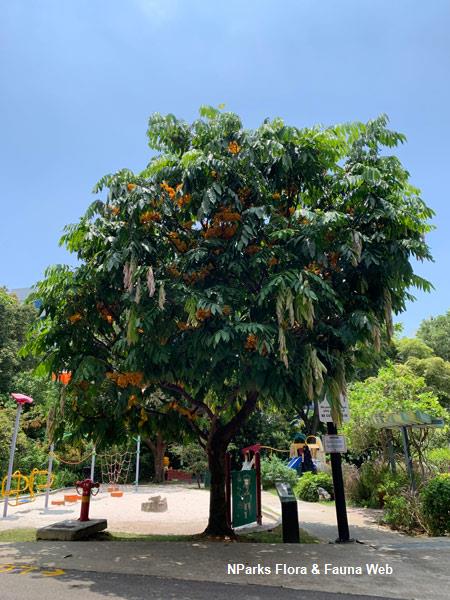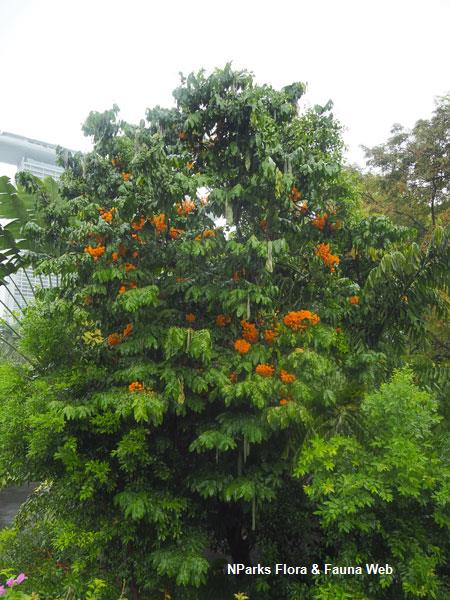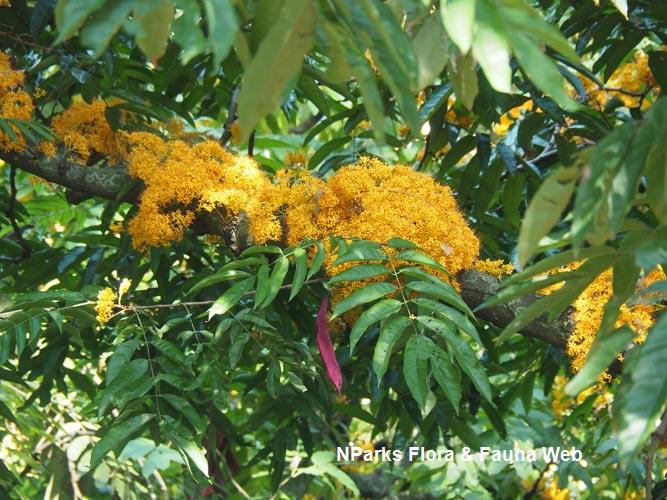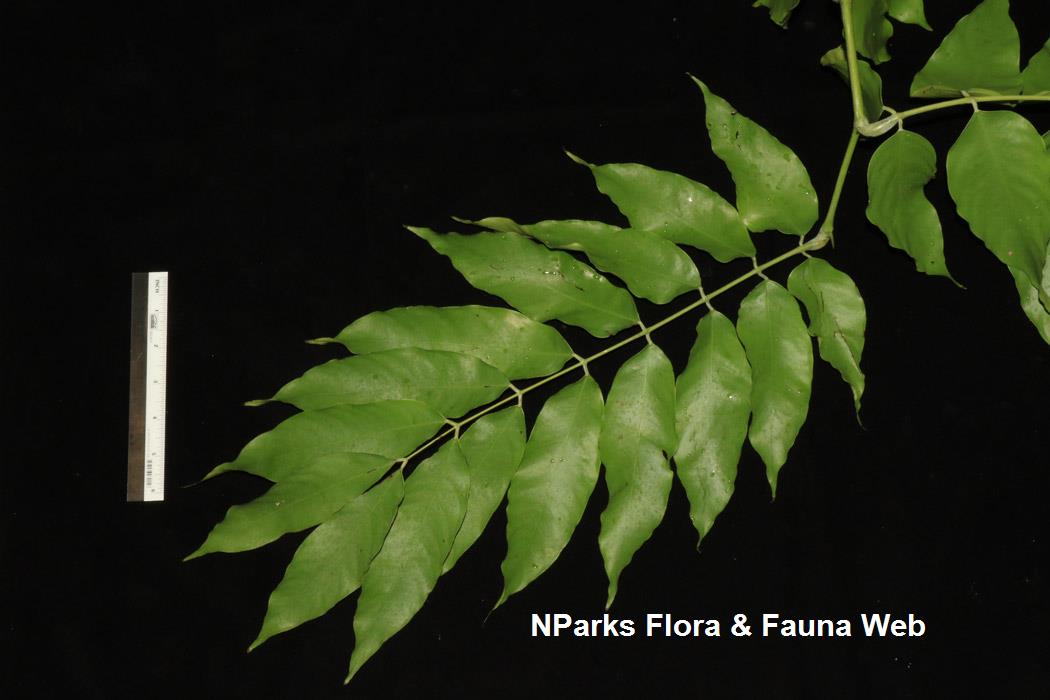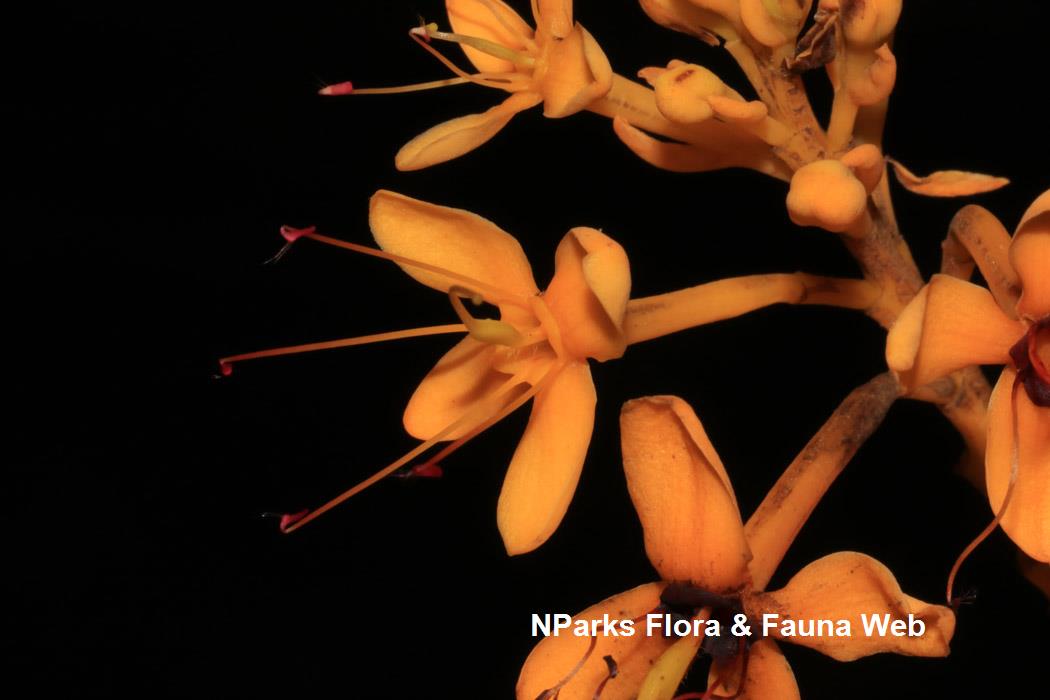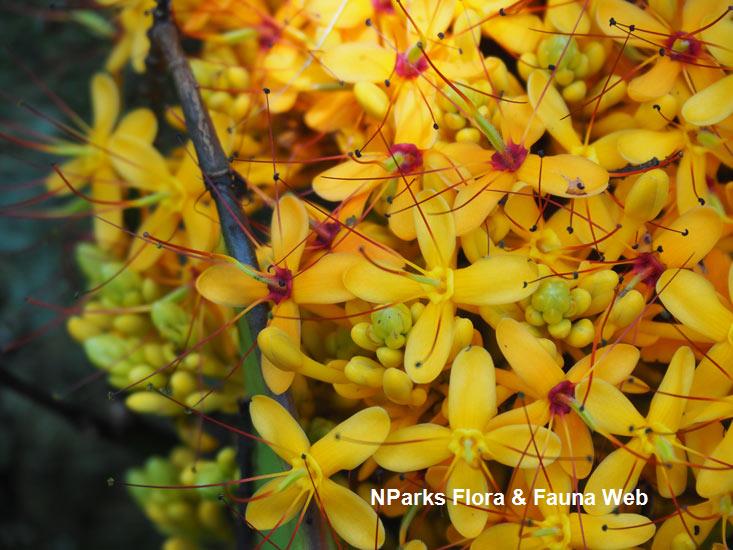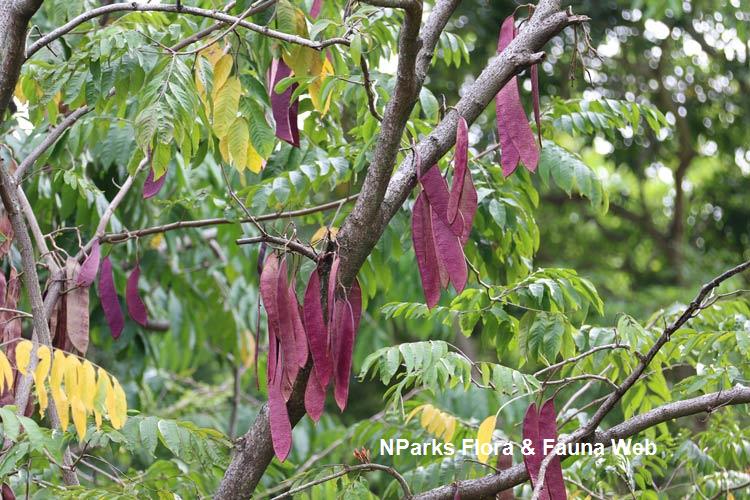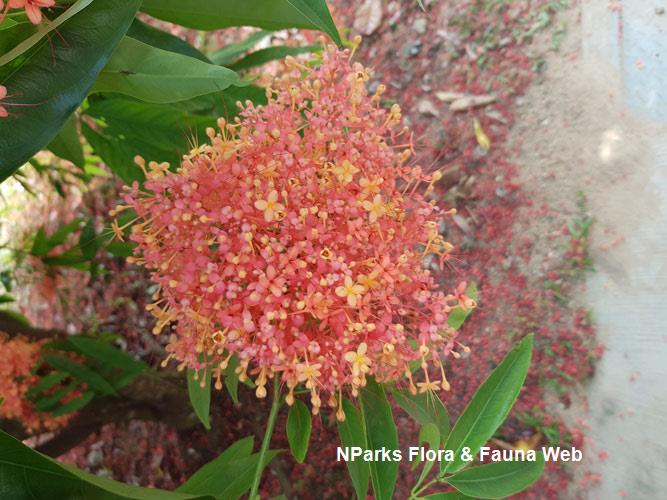
Back
Saraca thaipingensis Cantley ex Prain
| Family Name: | Fabaceae (Leguminosae) |
| Synonyms: | Saraca cauliflora Baker |
| Common Name: | Yellow Saraca, Gapis, Talan, 黄花无忧树 |
Saraca thaipingensis, also known as Yellow Saraca, is a tree prized for its large clusters of vibrant flowers. The flowers are yellow at first and changes to orange at anthesis and to red later. Found naturally in forests along streams and rivers, it thrives in cultivation when grown under full sunlight and fertile, well-drained soil.
Name
Classifications and Characteristics
| Plant Division | Angiosperms (Flowering Seed Plants) |
|---|---|
| Plant Growth Form | Tree |
| Lifespan (in Singapore) | Perennial |
| Mode of Nutrition | Autotrophic |
| Maximum Height | 24 m |
Biogeography
| Native Distribution | Myanmar, Thailand, Peninsular Malaysia and Java |
|---|---|
| Native Habitat | Terrestrial (Riverine) |
| Preferred Climate Zone | Tropical, Sub-Tropical / Monsoonal |
| Local Conservation Status | Non-native |
Description and Ethnobotany
| Growth Form | It is a tree, up to 24 m tall. The trunk can reach up to 38 cm in diameter. |
|---|---|
| Foliage | Leaves are compound and paripinnate. Each leaf has (4–) 7 (– 8) pairs of leaflets. Leaflet is oblong-lanceolate, measuring 7 – 32 long and 3 – 9.5 cm wide, with 6 – 12 pairs of lateral veins. The leaflet tip is sharply pointed (acute) to tapering (acuminate) while the base is rounded, obtuse or wedged shaped. The pair of leaflets closed to the leaf stalk is usually smaller than the rest of the leaflets. Young leaves flush white, pink or purple and hang pendulously like a tassel. They gradually turn green as they mature. |
| Flowers | Inflorescence is branched (corymb), measuring (8 –) 15 – 35 (– 40) cm wide. The flowers are yellow at first and changes to orange at anthesis and to red later. They may have a darker eye in the center. Each flower is accompanied by oblong lanceolate bracteole (0.6 – 1.7 cm long) which may fall off early. The flower stalk (pedicel) spans about 0.7 – 1.5 cm long. Each flower has (3 –) 4 (– 6) stamens. The filament is hairless and 0.85 – 1.7 cm long. The tree is observed to bloom several times a year in Singapore. |
| Fruit | The fruit pod is woody, thick and curved. It is narrowly oblong (about 15 – 45 (– 50) cm long and 3.5 – 10 cm wide) with a beaked tip (up to 1.5 cm long). Fruit pod ripens pink to purple-red. It coils and splits into two at maturity, revealing 6 – 8 seeds within. |
| Habitat | It is found in forests, often along streams or rivers, and occasionally on limestone forest, up to 1100 m altitude. |
| Associated Fauna | It is pollinated by insects. In Peninsular Malaysia, the hollow internodes are observed to be inhabited by ants (Cladomyrma species and Crematogaster species). <5> In Singapore, it is observed to be a host plant for several butterflies, including Hypolycaena erylus teatus (Common Tit), Jamides caeruleus caeruleus (Sky Blue), Jamides alecto ageladas (Metallic Caerulean), Jamides elpis pseudelpis (Glistening Caerulean), Semanga superba deliciosa, Drupadia ravindra moorei (Common Posy), Rapala pheretima sequeira (Copper Flash), Anthene emolus goberus (Ciliate Blue). <6> |
| Etymology | The genus epithet is derived from the Indian Sanskrit name Asoka. The specific epithet refers to Taiping, Malaysia, possibly the place where it was first described. |
| Ethnobotanical Uses | Timber & Products: The wood is sometimes used to make small utensils. <1, 7> |
Landscaping Features
| Landscaping | It is commonly cultivated in Singapore for its ornamental flowers. |
|---|---|
| Desirable Plant Features | Ornamental Flowers |
| Landscape Uses | Suitable for Roadsides, General, Riverine, Shade Providing Tree / Palm |
Fauna, Pollination and Dispersal
| Fauna Pollination Dispersal Associated Fauna | Butterfly-Attracting, Bee-Attracting, Butterfly Host Plant |
|---|---|
| Pollination Method(s) | Biotic (Fauna) |
| Seed or Spore Dispersal | Abiotic |
Plant Care and Propagation
| Light Preference | Full Sun |
|---|---|
| Water Preference | Moderate Water |
| Plant Growth Rate | Moderate |
| Rootzone Tolerance | Easy to Grow, Waterlogged Soils (Drains Site) |
| Propagation Method | Seed, Air-Layering |
Foliar
| Foliage Retention | Evergreen |
|---|---|
| Mature Foliage Colour(s) | Green |
| Mature Foliage Texture(s) | Smooth |
| Prominent Young Flush Colour(s) | Purple |
| Foliar Type | Compound |
| Foliar Attachment to Stem | Petiolate |
| Foliar Shape(s) | Non-Palm Foliage (Oblong, Lanceolate) |
| Foliar Venation | Pinnate / Net |
| Foliar Margin | Entire |
| Foliar Apex - Tip | Acute, Acuminate |
| Foliar Base | Rounded / Obtuse, Cuneate |
| Leaf Area Index (LAI) for Green Plot Ratio | 3.0 (Tree - Intermediate Canopy) |
Non - Foliar and Storage
| Trunk Type (Non Palm) | Woody |
|---|---|
| Root Type | Underground |
Floral (Angiosperm)
| Flower & Plant Sexuality | Bisexual Flowers |
| Flower Colour(s) | Yellow / Golden, Orange, Red |
|---|---|
| Flower Grouping | Cluster / Inflorescence |
| Flower Symmetry | Radial |
| Inflorescence Type | Corymb |
| Flowering Habit | Polycarpic |
Fruit, Seed and Spore
| Mature Fruit Colour(s) | Purple, Pink |
|---|---|
| Fruit Classification | Simple Fruit |
| Fruit Type | Dehiscent Dry Fruit , Legume / Pod |
References
| References | <1> Ding, Hou., Leiden, K., Larsen, K. & Larsen, S.S. (1996). Caesalpinioideae (LeguminosaeCaesalpinioideae). Flora Malesiana Series 1 Vol 12 (2) pg 409 – 730. <2> Gardner, S., Sidisunthorn, P. & Chayamarit, K. (2015). Forest Trees of Southern Thailand Vol. 2. Thailand. <3> Keng, H. (1990). The Concise Flora of Singapore: Gymnosperms and Dicotyledons. Singapore:Singapore University Press. <4> Larsen, K., Larsen, S.S., and Vidal, J.E. (1984). Leguminosae–Caesalpinioideae. In: Smitinand, T. & Larsen, K. (eds) Flora of Thailand. Vol. 4 (1), pp. 1 – 129. Bangkok: The Forest Herbarium, Royal Forest Department. <5> Maschwitz, U., Fiala, B., Moog, J., and Saw, L.G. (1991). Two new myrmecophytic associations from the Malay Peninsula: ants of the genus Cladomyrma (Formicidae, Camponotinae) as partners of Saraca thaipingensis (Caesalpiniaceae) and Crypteronia griffithii (Crypteroniaceae). Insectes Sociaux 38: 27 – 35. <6> Tan, H. (2016). Larval Host Plant for Butterflies: Yellow Saraca. Butterflies of Singapore. https://butterflycircle.blogspot.com/2016/03/larval-host-plant-for-butterflies.html (accessed 11 July 2024). |
|---|
Image Repository
Others
| Master ID | 1818 |
|---|---|
| Species ID | 3111 |
| Flora Disclaimer | The information in this website has been compiled from reliable sources, such as reference works on medicinal plants. It is not a substitute for medical advice or treatment and NParks does not purport to provide any medical advice. Readers should always consult his/her physician before using or consuming a plant for medicinal purposes. |

